how to fix a door lock cylinder
Planning & preparation
- Here we will show you how to replace three of the most common types of locks: a Euro Profile Cylinder Lock, a Mortice Sashlock and a Cylinder Rim Lock. We will also show you how to fit Door Security Bolts to a wooden door as an addition to existing security
- Bear in mind that different lock designs may have different fitting requirements, so be sure to always check the manufacturer's instructions
- When choosing replacement locks, it's best to go for BS3621 or Kitemarked products. In many cases, your insurer may insist on this
- If you are replacing a Mortice Sashlock on a final exit door, choose one with at least 5 levers that is certified to BS3621
- When replacing a Mortice Sashlock, you first need to select a product compatible with your old lock. If the distance from the edge of the door to the centre of the keyhole is 45mm, you need a 64mm lock. Or, if it is 57mm, you'll need a 76mm lock. Your new lock must also have the same distance between the centre of the keyhole and the centre of the spindle that connects the handles as the old lock. It will be simpler to fit if it also has the same or similar size of faceplate and strike plate
- All Euro Profile Cylinder Locks have the same profile (shape), so it is easier to find and fit a replacement. However, you do need to choose one that is the same size as the one you are replacing. Measure from the centre of the fixing screw to the outside of the lock on both sides. If the lengths are 45mm and 50mm, you need a 40:10:45 product, i.e. deduct 5 from each measurement and put a 10 in the middle. So, with measurements of 35mm and 35mm, you would need a 30:10:30 product
- If the Euro Profile Cylinder you are replacing sticks out more than 5mm beyond the door handle faceplate on the outside of the door, it is vulnerable to a 'snap attack'. Choose a replacement that will protrude less
- Whilst most Euro Profile locks have a keyhole on both ends, some have a keyhole on the outside and a thumb turn on the inside, which tends to be less secure
Do it right
- Clearly mark the position of your fixing points to ensure accuracy
- Be sure to only use screws or fixings that are provided by, or recommended by, the manufacturer
- If your door has glass panels, you can improve security by fitting toughened glass and making sure you have a key operated deadlock so that the handle can't be turned if the glass is smashed
Staying safe
- Wear safety goggles when drilling
- When using a chisel, wear safety goggles and be sure to chisel away from the body
- Doors can be heavy so it's best to ask for help when you are taking a door off its hinges or rehanging one
Aftercare
- Keep your locks clean and lubricated to keep them in good working condition. Be sure to only use products that are suitable for their material and finish, as using the wrong product could cause permanent damage
Replace a euro profile cylinder lock
Open the door and remove the central lock fixing screw.
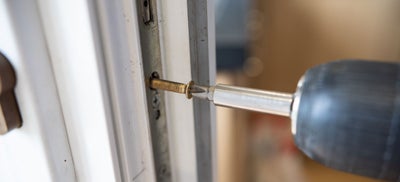
Slightly loosen but do not remove the door handles as this can ease removal of the cylinder.
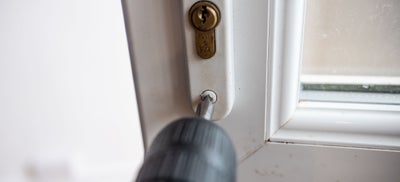
Place the key in the lock and gently pull it towards you as you turn it to the left (10 o'clock) or right (2 o'clock) positions to align the cam. When the cam is aligned, the lock should slide out towards you.
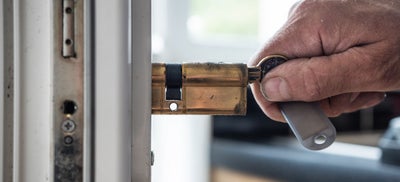
Insert the new cylinder into the lock and replace the fixing screw. Then, tighten the handles.
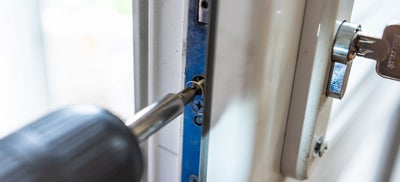
Use the key to test the new lock on both sides before closing the door.
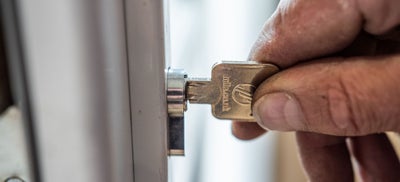
Replace a mortice sashlock
With the door open, turn the key so the bolt is in the locked position and remove the key. Then remove the screws holding the faceplate in position.
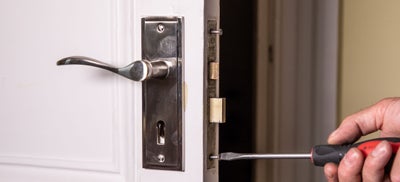
Remove the internal door handle and the spindle bar connecting the two handles. Retain this for refitting later.
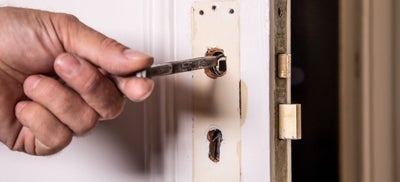
Use a pair of pliers to grip the bolt and pull out the old lock.
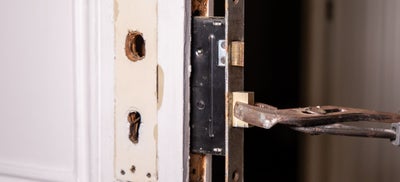
Compare the size and shape of the two lock bodies and faceplates.
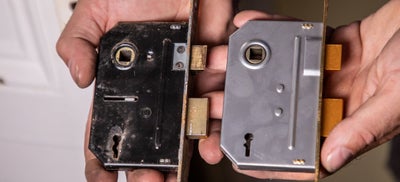
If the new lock body or faceplate is larger than the old, use a hammer and wood chisel to enlarge the mortice (hole) so the new lock fits properly in place.
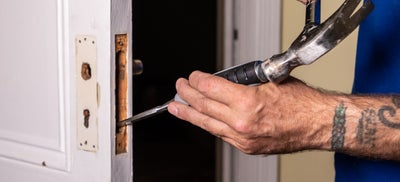
Once the lock body is in place, screw the faceplate into position. Then, replace the spindle bar and handle. Check that the new key turns smoothly in the lock.
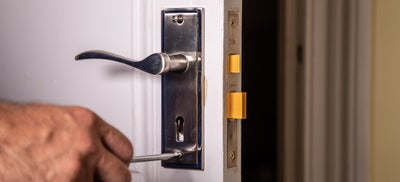
Remove the existing strike plate from the door frame, then hold the new one in position to test its fit. If need be, mark where adjustments need to be made to the recess, before using a hammer and wood chisel to remove the excess wood.
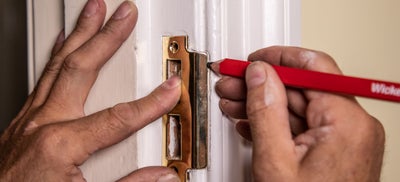
Secure the strike plate in position with the supplied screws.
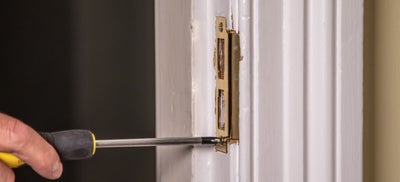
Finally, close the door and check the bolt engages properly with the strike plate.
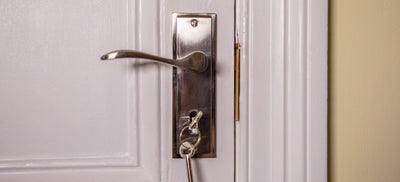
Replace a cylinder rim lock
On the inside of the door, unscrew and retain the existing lock body as it will be refitted later.
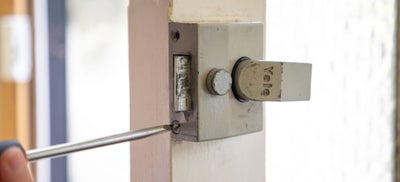
Then, unscrew the two screws that hold the existing cylinder rim lock in place.
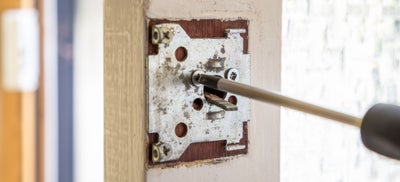
Push out and remove the old lock without moving the mounting plate on the inside of the door.
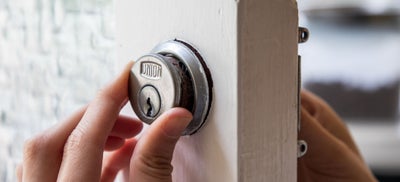
If the overall length of your replacement lock is longer than the old one, use a hacksaw to shorten the tail bar so the two locks are the same length.
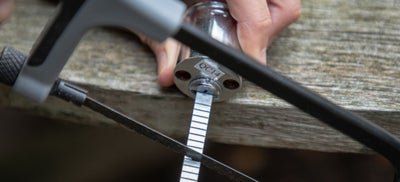
Push the new cylinder into place and fix with the two screws provided.
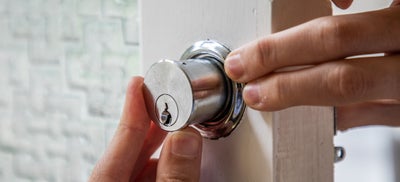
Screw the lock body back into position and use the new key to test that it works properly before closing the door.
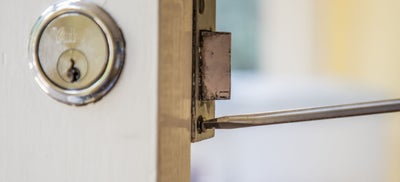
Fit a pair of door security bolts
Select a wood drill bit of the size recommended in the bolt manufacturer's instructions. Mark the depth of the bolt on the bit with masking tape.
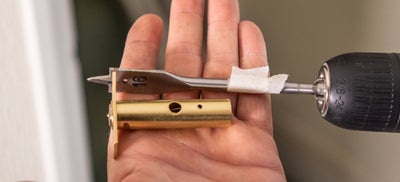
Drill a pair of horizontal holes, to the marked depth, into the centre point of the edge of the door. The holes should be near the top and bottom of the door.
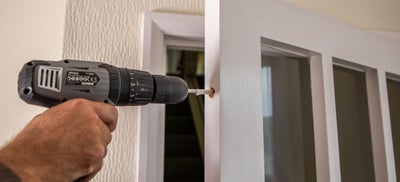
Slide the bolts into position and use a pencil to mark the outline of the end plates onto the edge of the door.
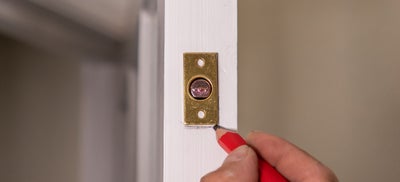
Use a hammer and chisel to remove wood from within the pencil marks so the end plates can sit flush with the door.
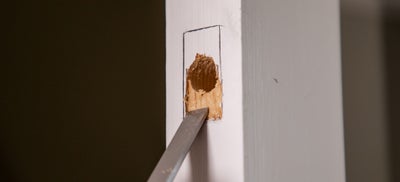
Next, hold the bolts against the inside of the door, flush with the edge and use a carpenter's awl to mark the position of the keyholes.
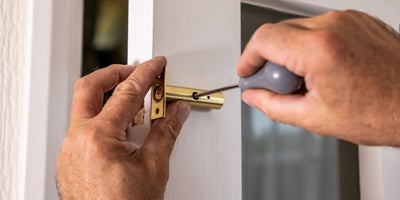
Using a wood drill bit of the recommended size, drill the keyholes – these should be on the inside of the door only and not right through the door.
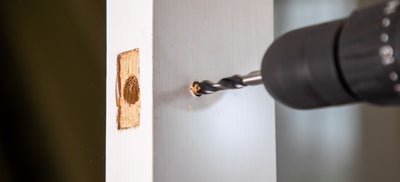
Place the bolts into position, then put the keys through the new keyholes to check they line up and turn smoothly.
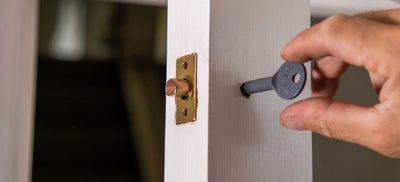
Use a pencil to mark where the end plate and keyhole plate screws need to go.
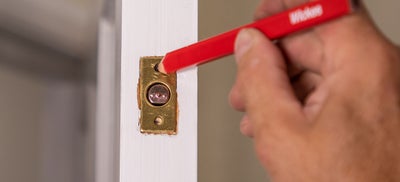
Use a small wood drill bit to drill pilot holes, then screw the end plates and keyhole plates into position. Double check that the key and bolt still turn smoothly.
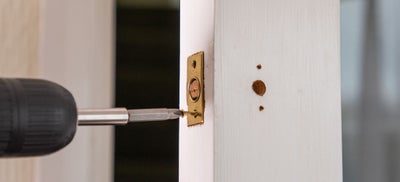
Follow the bolt manufacturer's instructions, and a similar process to that above, to drill and fit the strike plates. Most bolts have a small bump on the end that, when the door is shut and the key is turned, can mark the bolt's position onto the frame to ensure accuracy.
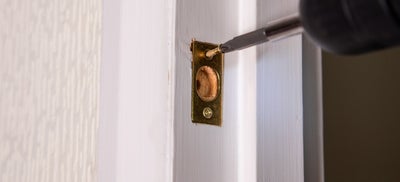
how to fix a door lock cylinder
Source: https://www.wickes.co.uk/how-to-guides/home-safety-security/fit-replace-door-locks
Posted by: dickinsondifusest.blogspot.com

0 Response to "how to fix a door lock cylinder"
Post a Comment